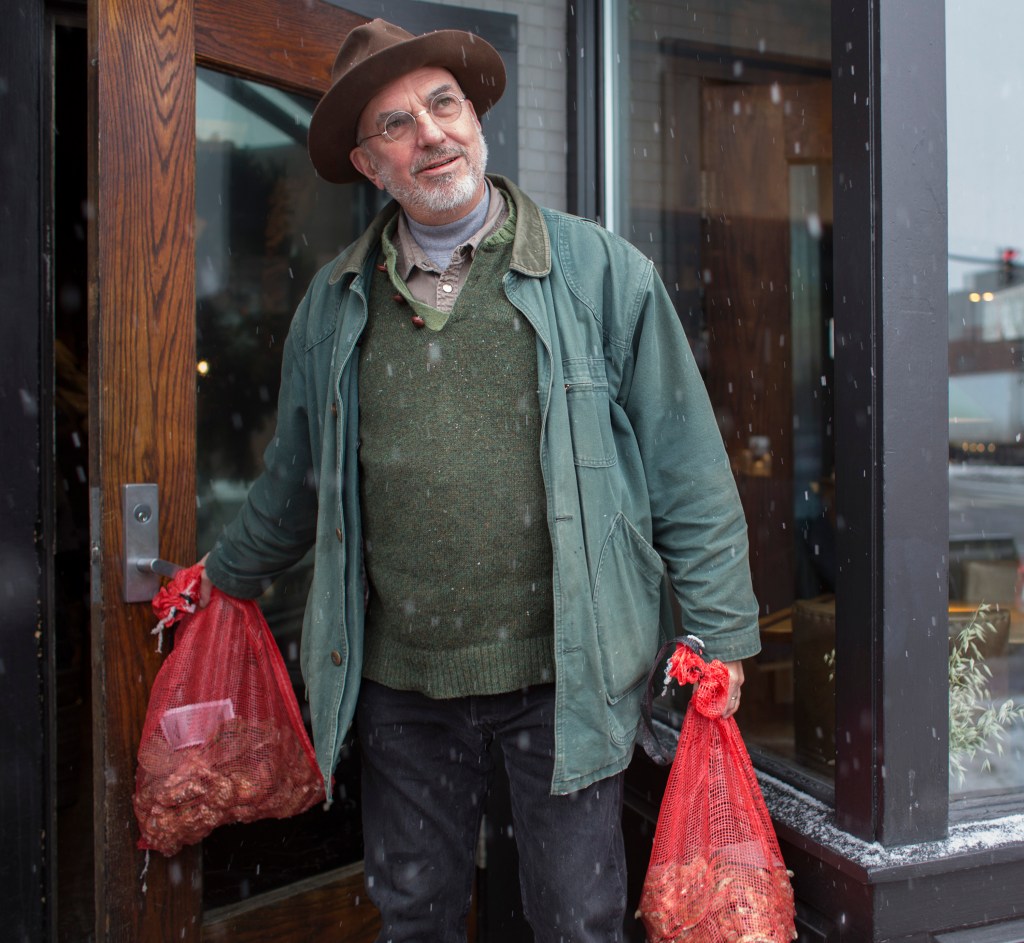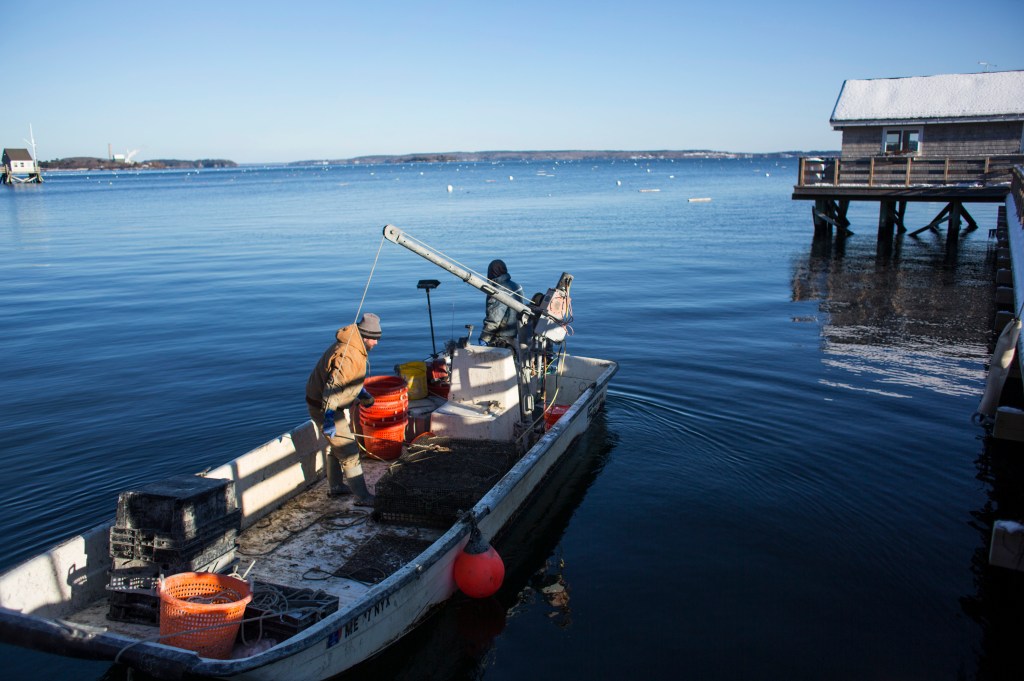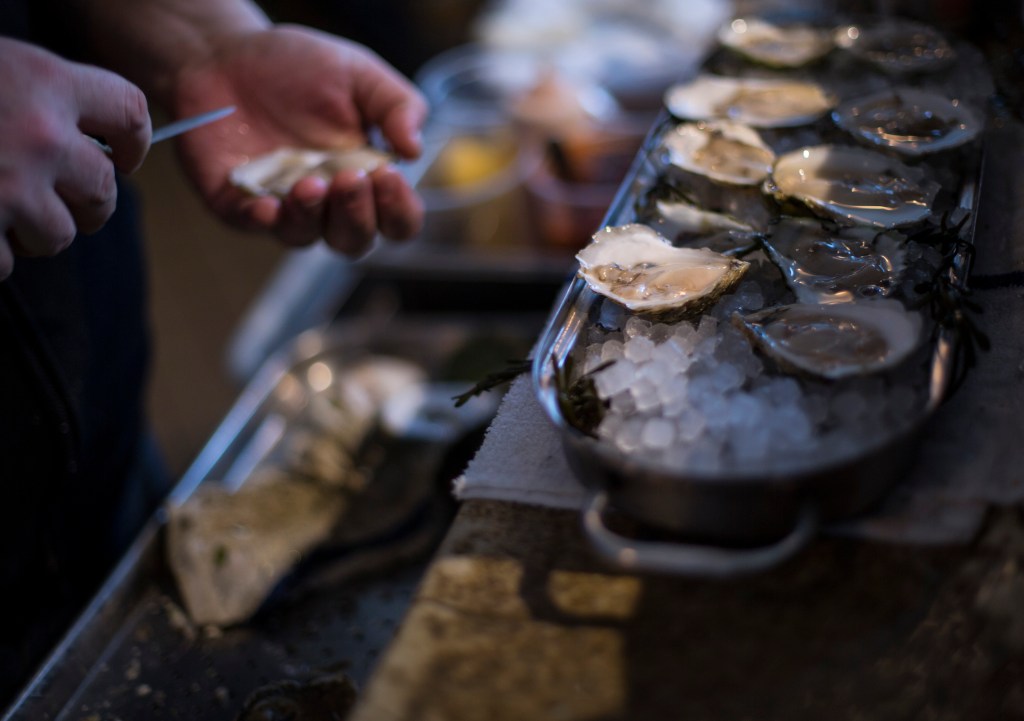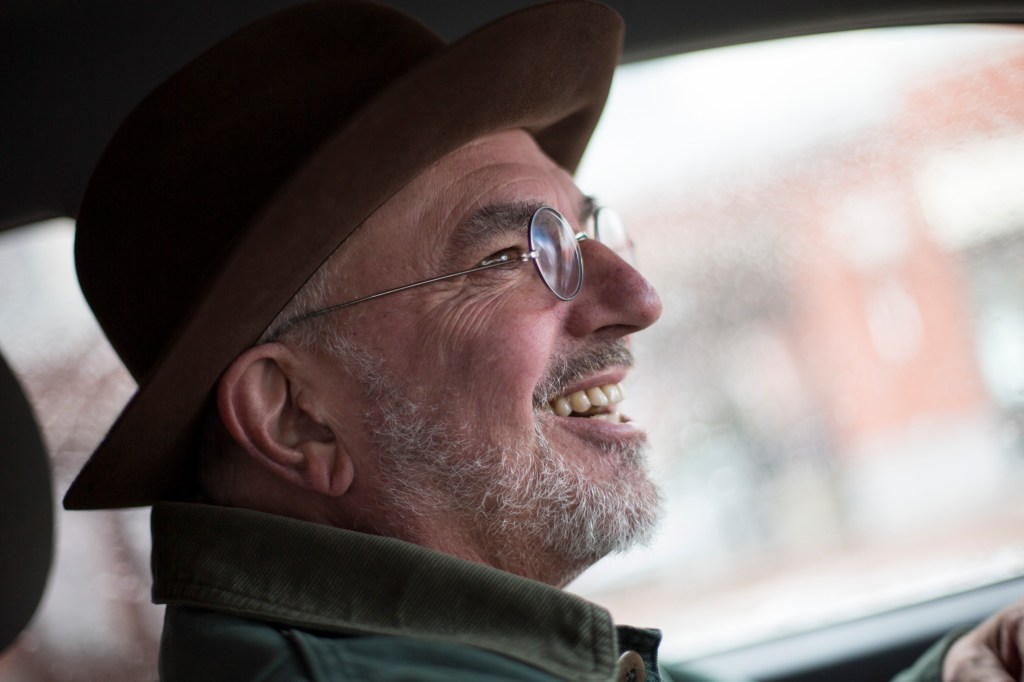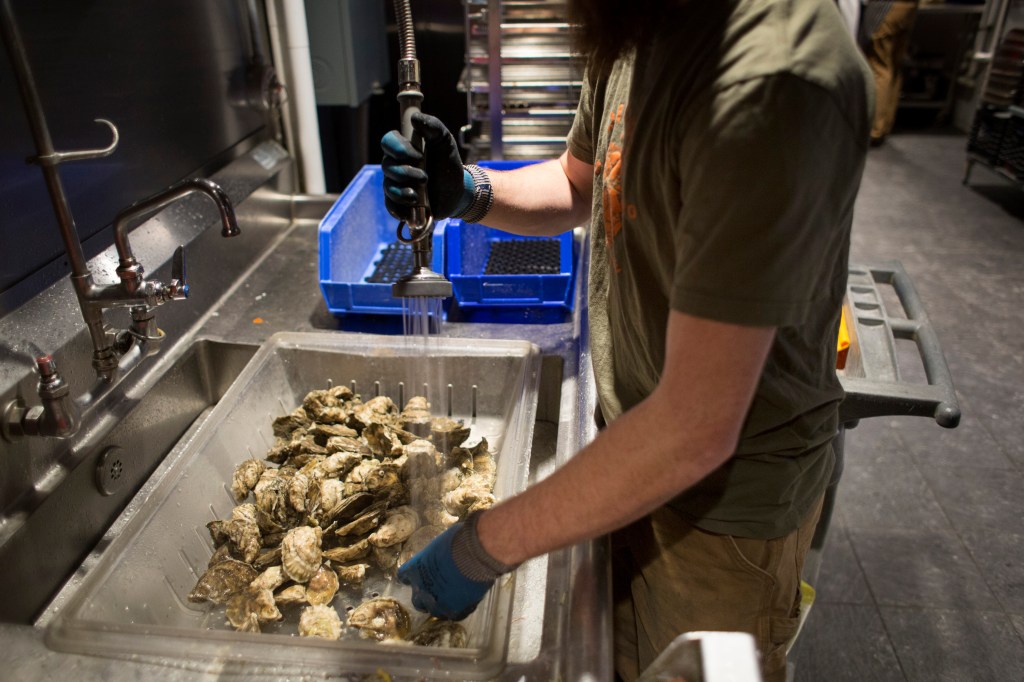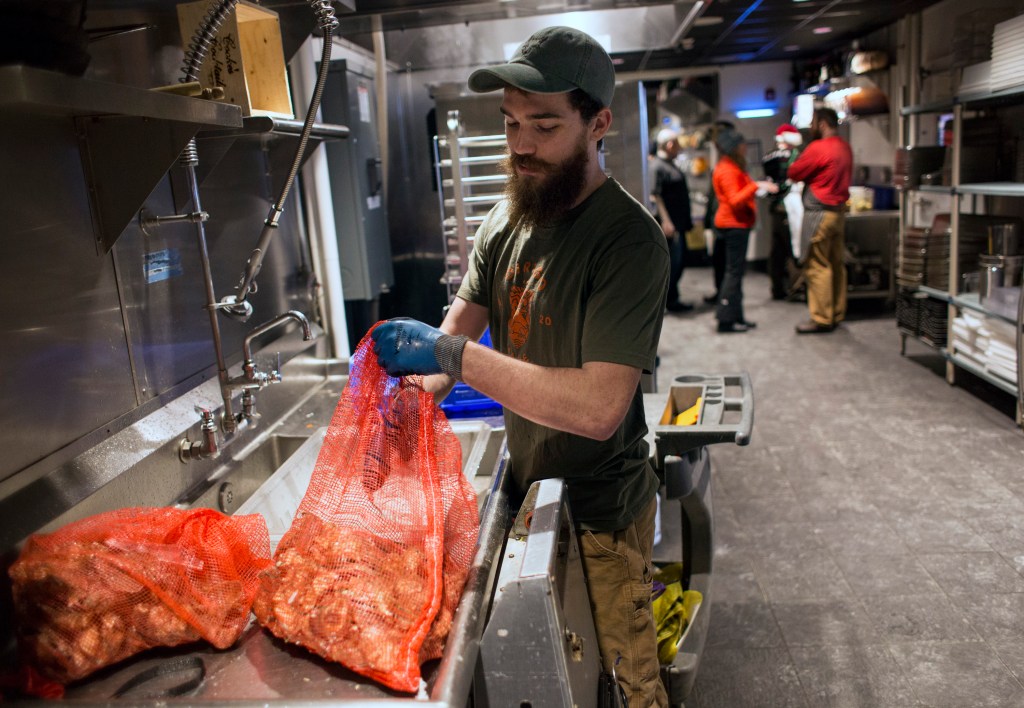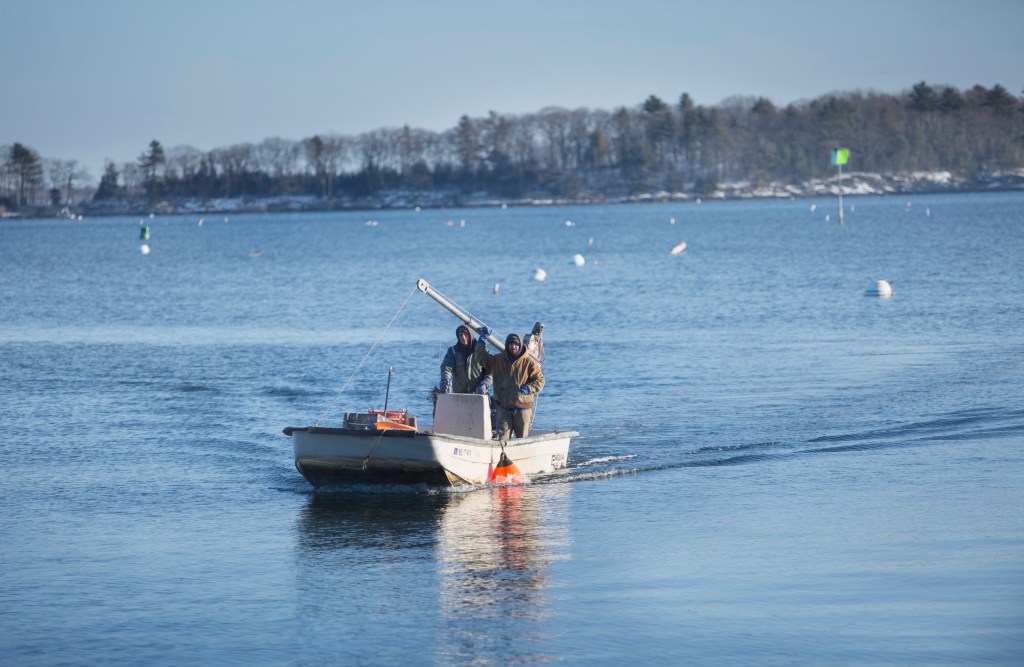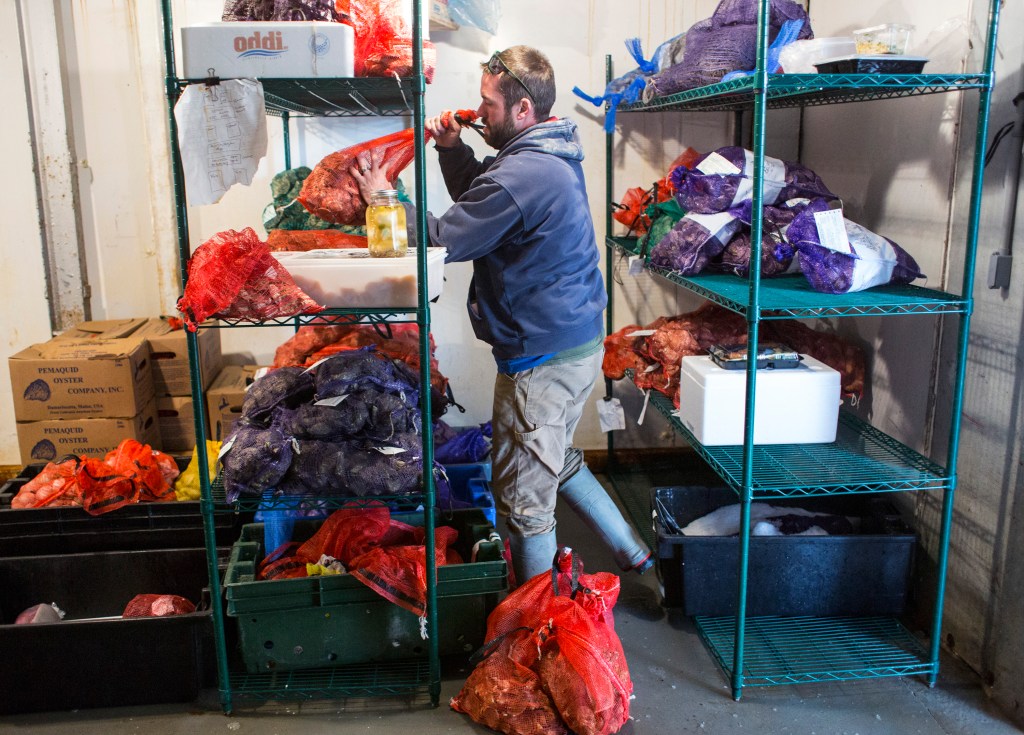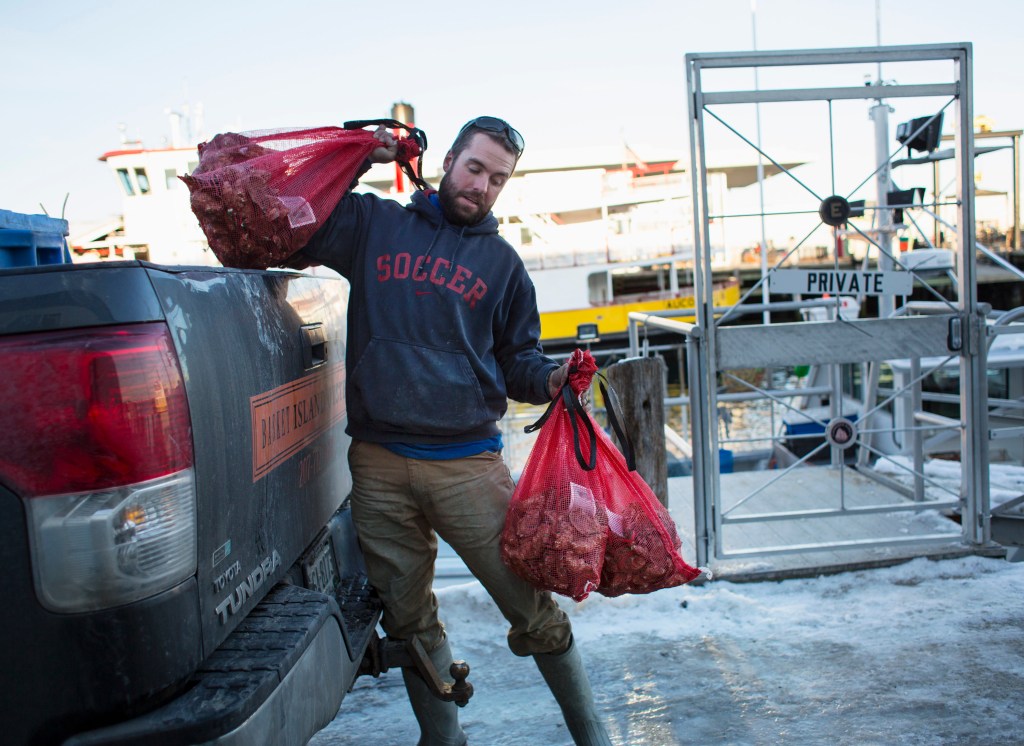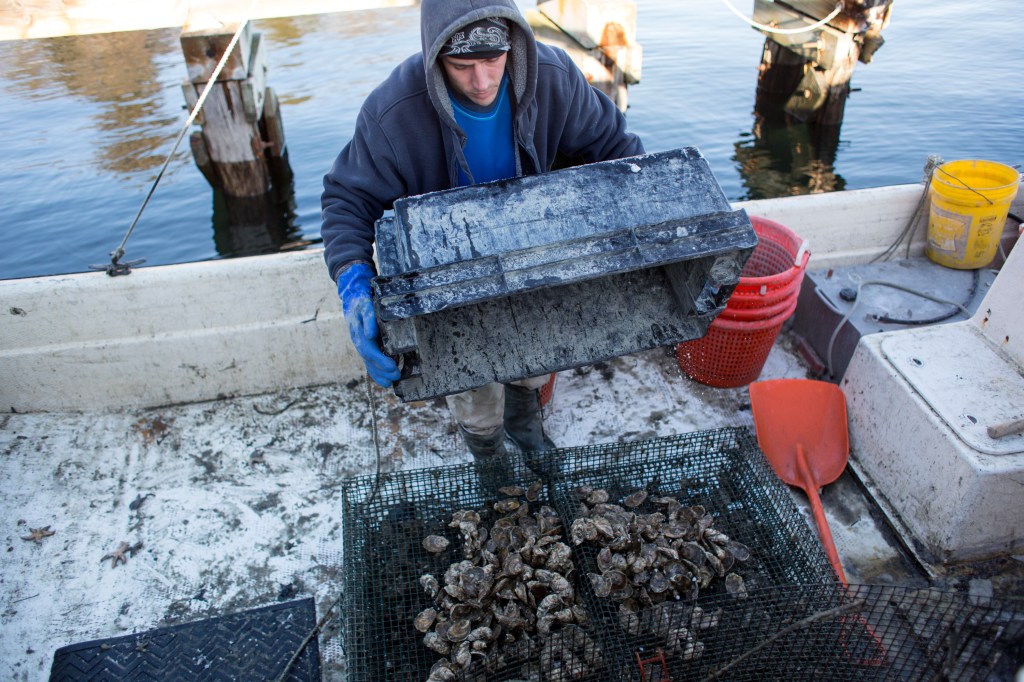FALMOUTH — Basket Island Oysters’ farm manager Lane Hubacz and all-around boat guy Emmett Huber arrived at Handy Boat just before 9 a.m. on the last clear day before Christmas. The duo had a couple thousand oysters to harvest. It was cold, hovering in the 20s, but a bright sun made the thought of a few hours out on the water more appealing.
Christmas was coming, along with the snow, and after that, New Year’s, when nothing goes quite as well with a glass of sparkling wine as a dozen oysters on the half shell. Basket Island Oysters are on the menu on some of Portland’s best restaurants, including Eventide, Fore Street and Scales, and chefs were calling for holiday orders.
Maine’s local oyster market is booming like never before. According to the Department of Marine Resources, Maine has somewhere between 75 to 90 mid-sized and large-sized oyster farms. (Basket Island falls into the former category, which covers farms from 5 to 15 acres in size.) There are also roughly 325 small – 400 square feet – experimental farms. At least 40 more applications are pending across categories, according to Jon Lewis, who heads up the aquaculture program for the Department of Marine Resources. At Eventide, that perennial favorite on national best-of lists, 3,000 oysters go out the kitchen door on a peak night in summer.
Customers may not know where Basket Island is – a 10-acre island one mile southwest of Cousins Island, owned by Chebeague & Cumberland Land Trust – or the specific origins of any of the other 11 Maine-grown oysters on Eventide’s menu. They might know only that slightly sweet oyster they slurped down with a flavored ice or a red wine mignonette is local, of Maine. And delicious.
But how did it get to their table? How long was its journey and what did it entail?
HEAT PACKS REQUIRED
Both men wore float jackets, thick and warm. Hubacz had on three pairs of socks and a couple pairs of gloves, including the bright blue rubber ones favored by fishermen. At Handy, they slid heat packs into their gloves before setting off for the farm on the well-used 24-foot Carolina skiff. The ride, Hubacz says, is usually the coldest part, so the warmer you go into it, the better. “If we can survive the drive out okay and stay decently warm enough, the longer we can be out working for.”
Basket Island Oysters has two plots in Casco Bay. The first is a 4-acre location off Basket Island. In 2014 they added a second, 1.2-acre lease near Littlejohn Island, where they are growing out a different “brand” of American oyster, Wolf Neck oysters. The species, Crassostrea virginica, is the same; in fact, the seed for both the oysters Hubacz and Huber are tending came from the same place: Bill Mook’s Mook Sea Farm in Walpole. An oyster can take up to three years to reach market size, and they develop different characteristics depending on where they are grown out or finished; these oysters spend about two weeks in the Basket Island location, where cool, deep water enhances their sweetness.

George Parr, owner of Upstream Trucking, grabs bags of Basket Island oysters before making a delivery to Eventide Oyster Co. restaurant on Dec. 22.
While Basket Island Oyster company has been around for about 10 years, originally as a hobby farm started by St. Joseph’s College professor of natural sciences Mark Green, it has surged as a commercial enterprise in the last four years. Hubacz was one of Green’s students at St. Joseph’s and after graduating in 2009 stayed on as a lab technician, assisting Green with an aquaculture class, among others. Huber is a graduate of Maine Maritime Academy and worked on tugboats. He grew up on Peaks Island, where Green lives. Both Huber and Hubacz started working for Basket Island full time about two and a half years ago.
“Science and navigation,” Hubacz says. “We’ve got it all.”
It’s a 45-minute boat ride between the two sites, and on this Thursday, Hubacz and Huber had to visit both and they had to do it fast, not just because of the cold, but because a toxic bloom meant state regulators had limited their allowable harvest time to 24-hour periods.
SHELLFISH SHORTHAND
There’s a lot of shorthand in the oyster world. “Markets” means oyster big enough to be sold. A bag means 100 oysters. “ASP” just means trouble. It stands for amnesic shellfish poisoning, an illness that can be fatal to humans. It comes from eating shellfish that have ingested domoic acid – carried by an active bloom of Pseudo-nitzschia, an ocean phytoplankton. This is the second year Maine has faced this particular kind of dangerous bloom, which is distinct from the well-known red tide.
When the bloom produces enough domoic acid to threaten human health, the Department of Marine Resources closes the coast to shellfish harvesting. This month marked the first recorded bloom of this particular phytoplankton in Casco Bay, and one that surprised officials by occurring so late in the season. Oyster farms like Basket Island are allowed to harvest only after they’ve submitted a sample of their product to the Department of Marine Resources for testing. If it comes back within the acceptable levels – Hubacz said Basket Island’s oysters have not yet shown any contamination – then the farmers can harvest, but only for 24 hours.
Hubacz and Huber had hit the water on Wednesday to get a sample – between 14 and 16 oysters – and brought it to the Department of Marine Resource’s drop-off point in Portland. On Thursday, they headed out to the farm to get to work. Though they hadn’t received the text letting them know they could bring their oysters to market, they got a head start. They’d start moving product around and sorting it, and if the test results weren’t good, they’d stop.
That Thursday they didn’t even see their usual companions, the bald eagles. “But we probably wouldn’t have seen them anyway because with the cold, we keep our heads down and just work,” Hubacz says, mimicking hunching his body against a wind. They went to the site off Littlejohn first, to pick up some of the Wolf Neck oysters and bring them over to Basket Island to finish them off. Basket Island has a barge that they move between sites every month or so; that makes a much better platform for work than the skiff.
The text pinged in at 11 a.m. Their oysters were cleared for consumption. This was a relief on multiple levels. With the weather, they don’t want to be on the water every day, but the sampling program means they have to go out at least two days in a row. And the Department of Marine Resources was closed for Christmas from Friday, Dec. 22, until Tuesday the 26th. Which meant the earliest they could harvest again was six days away.
To make the whole harvesting process less stressful, they move 1,200 oysters from the Basket Island site to underwater cages close to Handy Boat. They’d still have to sample 24 hours before bringing these to market, but the next time they sampled, it would be within view of the dock.
“It’s like musical chairs,” Hubacz says. In the summer, coping with a bloom is that much easier, he says, because they’re already out on the water every day. Wearing swimsuits. This latest round of sampling and testing has been going on for about a month.
“It seems like an eternity,” Huber says. “It adds another layer of complexity to our already logistical nightmare.”
Back on shore, they quickly pack the rest of the oysters into eight bags, 100 per bag. One good thing about harvesting in winter is that the oysters are fairly clean; no biofouling in December and thus no need to scrub them hard. Hubacz and Huber put them in an insulated cooler in the back of a Toyota Tundra emblazoned with the company’s burnt orange logo.
Then a call comes in from the guys out at Bangs Island Mussels. They needed a jump start, could Basket Island help? They head back out on another chilly boat ride. In the world of aquaculture, boats are like tractors, and if a neighboring farm is having trouble with its tractor? You go help.
ON THE ROAD
After the rescue, Hubacz climbs into the truck and eases it up the hill to Route 1 in Falmouth. He and Huber typically hand-deliver the Wolf Neck oysters to Island Creek Oyster Bar in Portland, but the oysters in the back of the truck, all Basket Island oysters, were bound for Upstream Trucking on the waterfront in Portland, their local distributor.

Lane Hubacz and Emmett Huber of Basket Island Oyster Co. return to Handy Boat boatyard in Falmouth after harvesting oysters in Casco Bay.
He passes the waterfront mansions of Falmouth Foreside on the left and then slips onto 295 for barely a minute, exiting on Washington Street, passing the green and yellow tumbledown garage with the million-dollar view, Maine Mead Works on the left and then turning onto Congress Street right where a giant mural of clammers at work faces out onto Washington Street. Two more turns and he pulls into the unloading dock at Upstream Trucking, which is tucked into the back of the same building that houses Scales Restaurant. (This is not a coincidence. Upstream Trucking’s founder, George Parr, is the fishmonger for Scales.)
Hubacz hoists the bags out slowly; 400 oysters hanging from each hand are heavy. He crosses the damp floor inside, heading right for a walk-in, where color-coded bags of oysters from other farms are already stacked deep on a metal shelf. Then he fills out some paperwork. His fat book of receipts was filled mostly with drop-offs at Upstream Trucking. The going rate per oyster to Basket Island on a late December day? 85 cents.
These oysters have traveled only 6.3 miles from the dock. And now they were out of his hands.
JUST UP THE STREET
The oysters spend the night on the metal shelf at Upstream Trucking. Oysters have a built-in advantage over most other shellfish: Their shells seal tight so they can last in a refrigerator for days and even weeks.
Not that George Parr is going to let those Basket Island oysters rest. Parr is a voluble sort whose background includes stints as a potter and a sea urchin dealer. He’s the kind of guy you want to hang around with all day, listening to stories, but he wants the newspaper in and out; this is a busy time of year for anyone in seafood (ask the police officer directing traffic into Harbor Fish, one pier over).
He checks in with Rick Humphrey, his manager, who stands in front of a desk full of color-coded ledgers that make it clear: This is command central. Deliveries have already gone out to Fore Street and to Scales – they walked them over, naturally. But Eventide still needs oysters, 600 of them, including 200 Baskets. At 11:18 a.m., Parr, hat already in place to catch the softly falling snow, walks out the door with two bags of oysters, and heads for his truck.
Humphrey, he says, is “my right-hand man, and I’ll tell you, he saves my life every day.”

Basket Island oysters at Eventide.
Parr started Upstream Trucking 16 years ago, and for years he walked around with the whole business in his head. “Now he documents everything I do,” Parr says of Humphrey. “He’s helped me double the business in the last few years.”
“It just keeps growing,” Parr adds. “We don’t advertise. And I’m doing, like, $5 million a year.”
Even in the accelerating snow, and the holiday traffic of people trying to beat the worst of the predicted stretch of bad weather, the Basket Island oysters only spent three minutes and 16 seconds on the next part of their journey. Parr pulls up in the loading zone at Eventide and hoists the bags of oysters out the back of his pickup truck.
The side door creaks open and a bearded man, Jason Eckerson, greets Parr. “This is Jason,” Parr says. “I come here for a cup of coffee every morning and get his order.”
Eckerson heads off toward the walk-in with the oysters but is intercepted by Sam Molloy.
“Do those need to be washed?” Molloy asks.
Molloy is in the nonstop oyster-shucking business at Eventide (“I counted 1,000 on a day in October”), and he sets about organizing the new batch of oysters. The first order of business is putting them into a crate labeled with their origin and their harvest date. Eventide still has some Basket Islands in the walk-in, and they are marked with a blue ribbon, to make sure they’ll be served first. But Eckerson’s hunch is, they’ll start serving the new batch of Baskets within 24 hours. “It’s a classic Maine oyster,” he says. “People love it.”
They’re small, they’re sweet and oyster farms don’t get much more local.
“It is right there,” Eckerson says. “They (customers) could take a ferry in to Casco Bay, and go right past it.”
But that Saturday afternoon, the couple from Boston, Ivana Shui and Alan Cong, who receive the first of that batch of Basket Island oysters, seem content right where they are.
Mary Pols can be contacted at 791-6456 or at:
Twitter: MaryPols
Send questions/comments to the editors.



